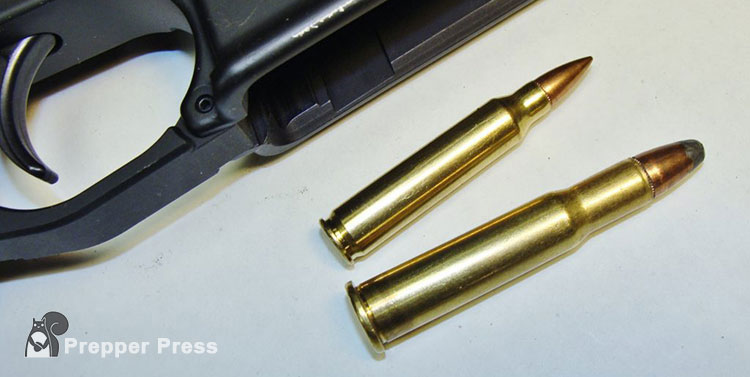
I wrote a post on .30 caliber options for the AR-15, and from that people are wondering about building a 30-30 AR-15. That would be nice, the deer hunter’s favorite, 30-30 Winchester sitting on the AR platform, complete with rails, advanced optics, and detachable magazines. Unfortunately, you cannot buy or build a 30-30 AR-15.
The Evolution of the AR Platform
People have been trying to stuff new cartridges into the AR platform ever since its debut. This includes the U.S. Military, whose efforts somewhat ironically took a turn 180-degrees out from those of today. The original Stoner/Armalite design was a much larger AR-10, chambered for the 7.62×51 NATO (.308 Winchester in civilian guise). Although fundamentally sound, Uncle Sam was interested in a lighter and more controllable version that generated less recoil.
The resulting select-fire M-16 rifle preserved the original AR design via a scaled-down rifle and cartridge combination. The latter was finalized in its military metric parlance as the 5.56 x 45mm. Today it’s more well-known as the 5.56 NATO (itself similar to the .223 Remington).
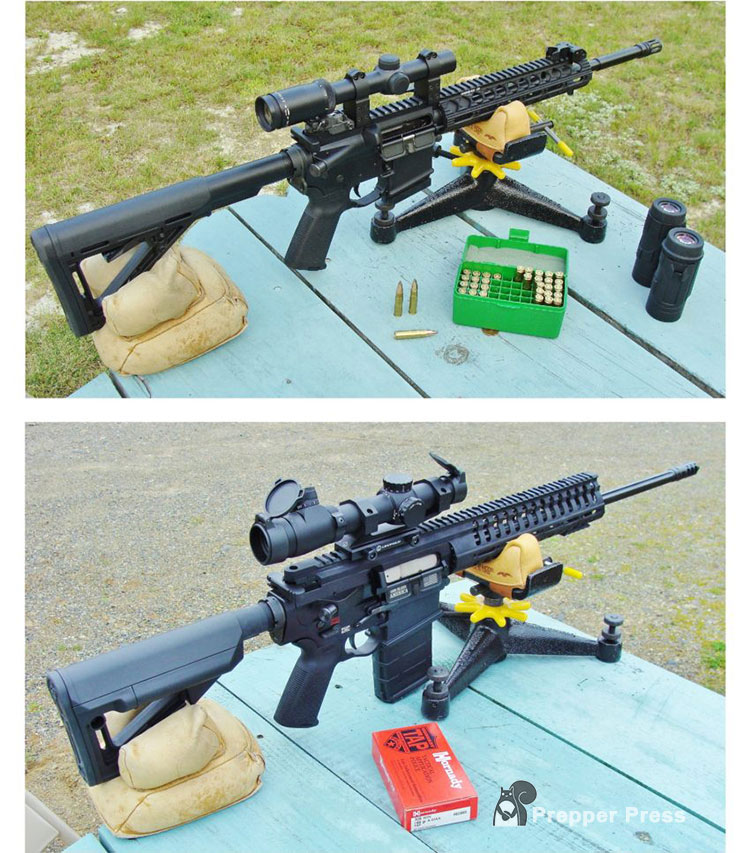
Sales of the semiautomatic AR-15 sporting types that followed grew and continued unabated. The ensuing half-century of evolution has led to numerous configurations and a still-growing list of calibers. But, one irony is the continuing quest for a level of .30-caliber punch inherent to the original AR-10!
Why not just go with a .308? You can, but this cartridge also won’t fit in an AR-15. Instead, you’ll need a much larger, original-sized AR-10 version. How about a somewhat smaller cartridge like the well-proven 30-30?
After all, it’ll cycle like a champ through any number of good lever-actions. They’re also manually operated, meaning gas pressure is irrelevant for purposes of function. Turns out there are also several other hurdles, too. Let’s take a look and gain some understanding of a conceptual 30-30 AR-15.
Initial Comparisons
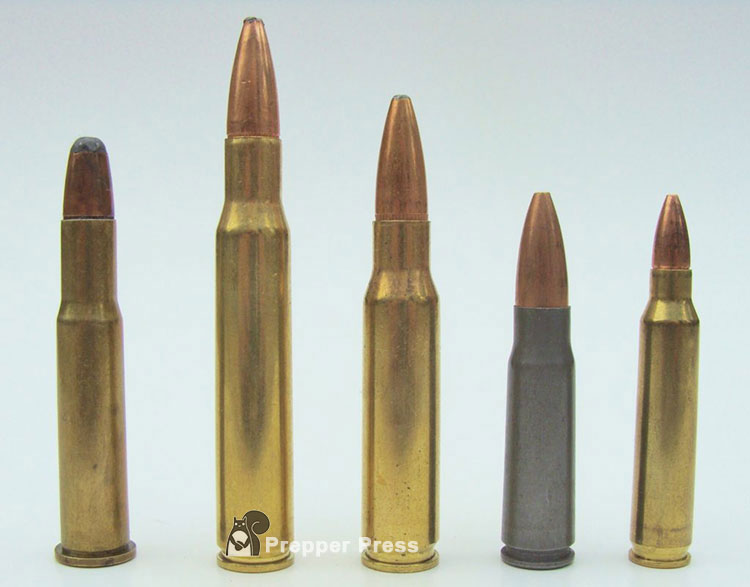
Place a 5.56/.223 cartridge beside a .30-30 Winchester and you’ll note some obvious differences. Many well-seasoned shooters would still consider the .30-30 a “normal-sized cartridge.” It has stood the test of time. These same shooters might also consider the 5.56mm a novel lightweight. That was certainly the case in the 1960s when it was a newbie. Here’s why…
5.56mm NATO
This cartridge is a product of the post WWII era, a period of rapid semi-and full-automatic firearms growth. As such, it’s suitable for detachable magazines. However, the big departure is its small but zippy projectile. Like many other .22 centerfire cartridges, they measure .224-caliber.
The original weight was 55 grains. Today some weigh more, but a 75-grain type is a heavyweight. The original 55-grain load had a listed muzzle velocity (MV) of 3250 feet-per-second (fps). You can dig deeper into .223/5.56 ballistics.
Truthfully, even with expanding bullets, such a load is light for most deer. I quit at big coyotes and then go to a larger caliber. Sometimes, for nostalgia’s sake, it’s the next one.
.30/30 Winchester
Dating to 1895, this cartridge was a perfect match for the repeating rifles of that era. Many were lever-actions that employed tubular magazines designed to feed rimmed cartridges. At the time, the bottle-necked .30 WCF was a breakthrough offering a stunning new level of velocity – but it still had a rim. Like most other .30 calibers in use today, the bullets measure .308-caliber. But, while most are aerodynamic pointed types, the 30-30 has long been sold with flat-tipped bullets for safe end-to-end magazine orientation.
The standard weights are 150 and 170 grains. The 30-30 is still no stranger to the deer woods and the majority are handy lever-action carbines. Mine is a 24-inch Winchester Model 64-A which drives a 150-grain flat-point bullet at 2350 fps. Compared to a .308 Winchester of the same weight that’s slow, but inside 150 yards, it’s all you really need for whitetails.
Dimensional Problems
So why not stuff a 30-30 in an AR-15? Well, the Devil’s in the details. Here in the U.S., cartridge dimensions and pressures are specified through the Sporting Arms and Manufacturing Institute (SAAMI). Of critical importance, they tie in with the types of firearms most likely to see their use.
For example, some older cartridges are throttled back in deference to older designs and metallurgy. Other limiting factors pertain to dimensions. Regarding an AR-15, things get interesting. After all, it was intentionally scaled down. As a result, suitable cartridges are limited by the relatively small dimensions of its bolt-face, action, and magazine.
It’s time to break out the Vernier calipers, starting with the magazines. The top opening of an AR-15 P-mag I checked was around 2.360” long. The spacing of its lips was .440”. Could a 30-30 cartridge even fit, making a 30-30 AR-15?
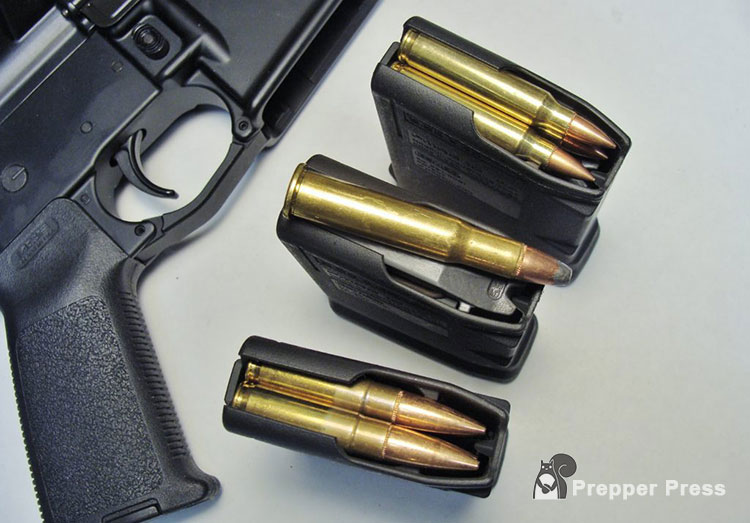
Cartridge Lengths
The maximum overall length of a loaded 5.56 NATO cartridge is 2.250”. That’s actually a tight fit in an AR-15 magazine. The 75-grain Hornady .223 TAP loads I checked measured 2.245”. A Remington 30-30 150-grain Core Lokt cartridge I measured was 2.575”; too long for an AR-15 mag.
Case Diameters
The fattest 5.56/.223 dimension is .375”. My factory 30-30 rounds mike .415”. What about its wider rim?

Rim Diameters
Like other modern magazine-fed cartridges, the 5.56 employs a rimless case for proper alignment and feeding when vertically stacked. Thus, its head mikes the same diameter as the body, .375”. This dimension factors in plenty of surrounding steel for safe containment of its feisty pressure. The bolt’s locking lugs are an integral part of the face so enlargement could result in cracks. As it turns out, the 30-30 is not only too long for an AR-15. At .500”, its rim is also too fat.
How Other AR-15 Calibers Work
Some other interesting cartridges (of suitable lengths) can be made to work through judicious modifications, starting with modified magazines that typically hold less rounds. The cherubic .450 Bushmaster is such an example. It also uses a rebated (undersized) rim, a trick that maintains the requisite bolt-face material. But the 30-30 AR-15? Its dimensions appear insurmountable – even without the pressure aspect.
Pressure. Like most other modern bottle-necked cartridges the 5.56 develops high pressure; actually a bit higher than the civilian .223 version (a reason use of 5.56 in those chambers can be unsafe). SAAMI maximum average pressure (MAP) for the .223 is 55,000 PSI. The venerable 30-30 is 42,000 PSI, possibly not enough to generate the requisite pressure for cycling of an AR. It’s worth noting burn-rates also play a role. Cartridges intended for gas-operated systems employ propellants that are formulated accordingly. In any case, it’s a moot point.
.30 Caliber AR Alternatives
All things considered, attempting to fit a 30-30 round in an AR-15 would be worse than trying to stuff the Incredible Hulk in a toddler’s snowsuit. Either way, something’s gonna give!
What about a 30-30 chambering for an AR-10? Well, why bother? Assuming it was even feasible, a 30-30 wouldn’t do anything the .308 chambering couldn’t do better in the same size platform.
BUT, HOLD ON! Two alternate AR-15 calibers are worth a look – and they’re both .30-caliber. The first is the .300 Blackout. The second is Wilson Combat’s new .300 HAM’R. Since these cartridges were designed specifically for AR-15s (unlike a 7.62×39 Russian which can be made to fit), the only necessary modification is a new barrel.
.300 Blackout
I own and shoot a bunch of AR-15s (and a few other types) in this caliber. Today, it’s extremely popular, in part due to its subsonic capabilities which are perfect for quiet use through suppressors. But, in supersonic form, it’ll achieve the same MV as a 150-grain 30-30; roughly 2350 fps. Read more on .300 Blackout loads.
The kicker: This requires lighter bullets in the 110–120 grain range. I overcome penetration concerns by using solid-copper types, which are also pointed “Spitzer” types that flatten trajectory. Commercial ammo is widely available (at least, during normal circumstances), so if you find a bargain, buy ammo cheap and stack it deep. I’ve also formed my own brass from shortened and neck-expanded 5.56 brass.
.300 HAM’R
The new .300 HAM’R is all about speed. It’s essentially a 5.56 case neck-expanded to .30 caliber. Wilson’s goal was to reach or exceed the performance of a 30-30 and the results were so successful that they considered naming it the 30-30 AR-15. Using the same 150-grain bullet standard, the HAM’R’s MV is just below 2300 fps; similar to many lever-action 30-30 carbines.
Closing 30-30 AR-15 Thoughts
Both of the above loads are now SAAMI-approved calibers, a U.S. benchmark of established recognition. But, if ammo is a concern, a switch-top .30 caliber upper-receiver assembly could easily be added to a standard 5.56 AR-15.
You could also just buy an affordable AR-10 rifle in .308 Winchester and be done with it. It’ll be larger and contain some proprietary parts but, with 150 -grain bullets, you’ll gain an honest 300+ fps (with enough steam to handle heavier weights of 165- 180 grains). Recent efforts have reduced the weight this platform somewhat. Patriot Ordnance has even managed to pare down its size through their new Revolution model.
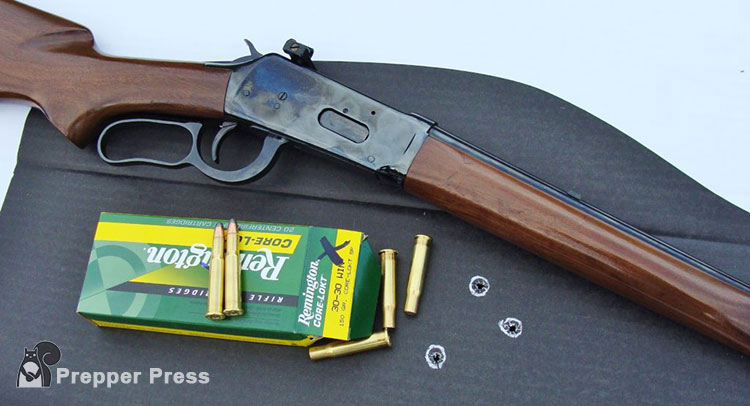
If your 30-30 itch still needs scratching, drop the idea of a 30-30 AR-15 and focus instead on the classic lever-action rifle. A couple brands even come with some tactical accoutrements. As far as rimmed cartridges in semiautomatic rifles go, the only popular tubular-magazine example I can recall is Ruger’s original Deerslayer, chambered for the .44 Magnum. If you happen upon one be smarter than I was and hang on to it.
3 comments
So, if I’m reading this article correctly – you can’t mod an exiting AR-15 rifle into a 30/30. Okay, I get that. What about manufacturing an AR platform rifle chambered in 30/30? 7.62×39 has a little more chamber pressure @ approx. 45,000 psi. Also, instead of a gas-operated system, what about piston-operated system?
The 350 legend gives you virtually identical ballistics, bullet weights, velocities etc as the 3030 and is a 35. Cal bullet that works great in the ar platform.
You don’t have the same ballistics and reach 2350 with a 150 grain bullet in a 300 blackout unless you have a very long barrel which is what the 30-30 shoots. Some of the LeverEvolution loads are faster than that. You can reach that with 110 grain loads though but not the same as a 30-30. Its Funny with all the people who jumped on the .300 band wagon and jumped right back off due to them finding out the truth. It only shines suppressed.